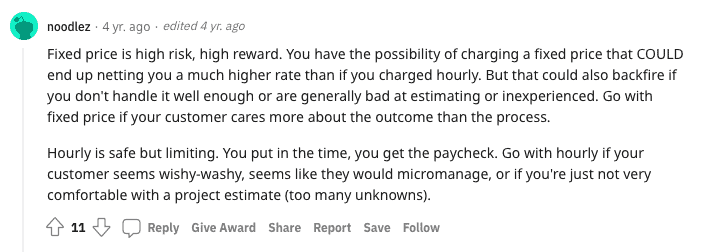Chocolate or vanilla? Red pill or blue pill? Flat rate or hourly?
These are some of life’s most important questions and fiercest debates.
But we won’t shy away from a challenge. So let’s attempt to settle this once and for all.
In this guide, you’ll learn examples of when to use either pricing model, which is more effective, and how you can utilize both models to maximize profitability.
Let’s dive in!
What is a flat rate?
A flat-rate pricing model charges a fixed fee for a service. For example, a web development agency charges $8000 for a website.
This is typically done based on calculating how long it will take to complete the project in hours and then multiplying that by your hourly rate. And, of course, adding a buffer for any unexpected requests.
What is an hourly rate?
An hourly rate is a fixed amount you or your business charge or earn for every hour worked.
For example, a website development agency may charge $120 per hour for a website build instead of a flat fee of $8000.
Most agencies and freelancers start out charging by the hour. But is it the best pricing model to help you scale your business?
Note: This is also known as Time and material (T&M) billing. You still charge per hour but also include the cost of materials associated with the project.
Flat rate vs hourly — pros and cons
Let’s look at some of the pros and cons of both pricing models.
Pros and cons of flat rate pricing
Pros of flat rate pricing
1. Rewards you for being efficient
Flat rate pricing is excellent for setting yourself up for more income and growth.
Sometimes without even doing any extra work.
How?
A flat-rate project rewards you for being efficient.
The faster you can complete a project, the more profit you make. So the more experienced you become, the more you get paid.
For example, say you’re creating a standard 5-page website for a local business. You charge $5,000 for it, which takes 30 hours to complete.
But as you become more experienced and efficient with your work, it’s only taking you 20 hours.
In the first scenario, your average billable rate is around $166 per hour.
In the second scenario, your average billable rate is $250 per hour.
You’re charging $5000 in both scenarios. But thanks to your efficiency, you’re now making more profit per website than before.
Many Reddit users agree with this, too.

Give this video below a watch. Chris from The Futur explains how this works pretty well.
2. Happier clients
Flat rates are painless for clients to understand. They know upfront what the project will cost. Plus, there’s no arguing about how long something took (e.g., the client can’t say it took you 100 hours to do a website they thought should be done in 50).
When you lay out precisely the amount of money going into an agreement, it minimizes pay disputes and confusion.
3. Predictable income
Having a fixed fee for your services means you can anticipate the amount of money you will receive per project.
Here’s a quick scenario:
- A client needs one 10,000-word eBook for a flat rate of $1,000
- Another client needs two 10,000 eBooks for $1,000 each
- So these two jobs will be worth $3,000
Hourly rates will only give you an average ballpark, but a flat rate is neat, tidy, and predictable.
Again, you may also have several clients on fixed-fee monthly retainer agreements – perfect for predicting income.
Cons of flat rate pricing
1. You take on most of the risk
Fixed-rate projects are OK if you can manage the risk. But there is a strong possibility that you risk the project failing if you don’t have your documentation nailed down.

For example, whenever a new project comes in, you should create a Work Breakdown Structure to fully understand the phases and tasks involved in completing the project.
Once you fully understand the scope of the project, you can then include that in your statement of work.
Fixed price, fixed scope. Change scope? Change price.
2. Flat rate projects can be harder to sell
Certain clients are sticklers for an hourly rate. And they’re pretty insistent.
Additionally, when the client knows the charge upfront, it opens the field for negotiation and haggling.
“Does a website really cost that much?”

Some clients need convincing. And let us be frank with you, you don’t want to work with clients who think they can negotiate your price down.
So it’s probably best to avoid low-budget clients where you can. They tend to be super high maintenance.
Consider raising your rates if you find yourself constantly dealing with low-budget clients.
Don’t know how best to deal with low-budget clients? Check out this video.
Hourly billing can also be harder to sell. For example, a client may be comfortable with a flat fee of $5000 for a website. But as soon as you tell them your charge hourly and it’s going to cost them $150 an hour – they may run for the hills!
3. A potential decline in quality
When you earn more by completing more, it’s difficult not to rush.
Rushing through projects and cutting corners is a common sight when you aren’t paid per hour.
Sometimes, agencies take on projects at lower rates to keep their business ticking over. This leads to tight project profit margins, which can lead to corner-cutting.
Not only will your reputation begin to take a hit, you may also find yourself struggling to make a profit.
The best way to avoid this happening in your business is to nail down your work processes and create Standard Operating Procedures (SOPs) where you can. Making them can help improve the overall quality and consistency of your work.
Pros and cons of hourly billing
There are situations where flat rate pricing isn’t ideal, but hourly billing shines.
Pros of hourly billing
1. The client takes on most of the risk
Most clients don’t know what they want and can be a little lost when it comes to the project’s scope.
They’ve got a boatload of ideas but don’t know how easy they are to execute. They obsess over minor details but leave out some critical elements and then claim “that was obvious.”
Hourly billing means you get paid for the hours you work. Shifting the risk onto the client.
This is especially the case with software development — where scope creep tends to thrive. 💀

2. You don’t have to worry about blowing project budgets
“Is this project going to be profitable this time?!”
Not really a question you have to ask yourself when billing per hour.
You might have to provide ballpark figures, but you may not have to sweat over changing project variables and scope.
This is a significant benefit if you’re constantly dealing with scope creep.
With hourly billing, you force the client to work with you so that the project is in check and they don’t have to pay more than their budget.
Plus, if you’re bad at estimating the cost of your projects, you may prefer hourly billing.
3. It helps the client to get a better understanding of where their money went
Hourly billing is what a lot of clients are familiar with. So it gives them a better sense of where their money is going. For some clients, this familiarity provides a straightforward way of comparing one agency to another.
Being able to evaluate your value quickly helps to speed along client conversations. And they’ll be more likely to want to discuss the next steps and contracts.
For many clients, hourly billing is clear and understandable.
Cons of hourly billing
1. It punishes efficiency
Efficiency is the enemy of hourly billing.
For example, let’s say you have a junior designer in your agency that takes 5 hours to create mockups for a one-page website. But it takes your senior designer 2 hours.
Should you be paid less?
Hell no.
You could increase your hourly rate and temporarily solve the problem. But it doesn’t always work this well.
The higher your hourly rate, the harder it can be for a client to swallow the idea of hiring your agency — even if you have the experience to back up the price.
2. Having to justify your time
If you’re working with lower-budget clients, there’s a good chance they may constantly question your time.
“Why did it take X hours? That seems crazy! Surely it can be done faster?”
Giving a flat fee upfront is likely to put a stop to this altogether.
3. Can stunt your growth
The more efficient you and your team get, the more time you’ll have on your hands, which means you can take on more projects.
But with hourly billing, you can only fit as many projects as you can into the work week. So you may find you hit a ceiling at some point.
Hourly rates allow you to take on as many jobs as possible to fit into the work week, limiting the number of clients and projects available to you.
Plus, you’re not paid for the value your project delivers to your client. For example, a logo may take just three hours to create — but its value to a business may be higher.
Which is better? flat rate or hourly?
Both pricing models have their pros and cons. But there’s no reason you can’t use both.
How do you decide?
The “trick” is to understand your work’s value and the risk you’re taking.
The best way to describe risk in this context is to ask yourself,
“How accurately can I estimate the number of hours that it’s going to take to get this done for the client?”
For example, you may have extracted all the project requirements from the client and find they’re still unsure of the scope of work.
This may be because the project is overly complex or requires many moving parts.
The best way to work out the value of your work is to ask yourself,
“How commoditized is this product/service I’m selling?”
Be honest with yourself here. If you’re building websites without specialization, you can consider your work lower value.
Why? Because there are probably many other businesses selling the same type of service.
When to use flat rate pricing
Communicating with the client before engaging in work is the key to making fixed fees successful.
You need to know what’s to be delivered and then have the ability to translate that into an air-tight statement of work.
Flat rate pricing is perfect for the following types of work.
- The work is of low value and risk
- Small projects with predictable phases and tasks
- You can easily estimate the cost based on previous projects
- The scope of work is concrete, and requirements are clearly defined
Examples of when a flat rate makes sense
Scenario #1
A graphic designer with years of experience is quick to do their work and is accustomed to making estimates. They can more or less glance at a job and accurately estimate the hours it will take to complete it.
Scenario #2
A content writer charges a flat rate for blogs and articles. It’s a short-term cycle, as pieces are delivered monthly and have a reasonably predictable focus and outcome.
This means they have a low risk of project scope creep and a flat rate is ideal.
Scenario #3
A content creator that offers standardized packages and services.
The risk of getting underpaid is much lower when the process is pretty repeatable and scalable.
Plus, every customer is getting the same package.
- 1 month of newsletters for $500
- 3 months of newsletters for $1,400
- 6 months of newsletters for $2,500
Scenario #4
Any freelancer or agency whose work is consistent in scope, hours, and effort required. Charging a flat rate will allow them to hammer out project after project in days or weeks.
When to use hourly billing
Hourly billing is better suited for work where there is a higher risk of the project shifting in scope or the requirements can’t be fully defined.
Highly custom work is also better suited for hourly billing. Such as custom mobile apps for large enterprises for example.
Hourly billing is perfect for the following types of work:
- High risk, high-value work
- The project scope can’t be fully defined
- Long-term projects with dynamic requirements
- The scope of work is expected to shift as the project progresses
Examples of when hourly billing makes sense
To give you an idea of when to choose an hourly rate pricing structure, here are a few scenarios:
Scenario #1
A long-term social media or PPC marketing campaign. They have a set goal regarding the number of new leads or followers but not an exact time frame and are subject to frequent changes.
Scenario #2
A relatively new design company may choose an hourly rate. Although many designers may pick a flat rate, an hourly rate is wise if you lack experience and historical knowledge for making accurate project estimates.
You wouldn’t want to risk getting underpaid from inexperienced estimates.
Scenario #3
Most in-house work, like bringing in consultants and subject matter experts.
You generally treat contingent workers like consultants and SMEs as temporary employees, and hourly rates will allow you to calculate their wage like any other employee coming in for a day’s work.
Scenario #4
A freelancer doing retainer work will benefit from an hourly rate.
The company that hires them pays a flat fee on the surface, yes – although this is just a retainer fee. A fee to seal the deal and ensure commitment.
But each time the retainer performs a service for the organization, they receive an hourly wage.
Flat rate vs. hourly — the battle rages on
There will never be one “best” answer for every occasion, but it is essential to weigh all the pros and cons of each pricing model, as well as assessing the value of your work and the risk you’re taking on.
Want to make sure you’re getting paid what you’re worth?
Check out our guides below for some additional reading
- Project Cost Estimating: How to Nail Your Estimates
- How To Track Billable Hours & Increase Profits by 20%
Sean is a Content Marketer at Toggl. He's been involved in SEO and Content Marketing since 2017. Before working for Toggl, Sean ran SEO at a digital marketing agency—so he's all too familiar with time tracking and project management.

